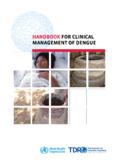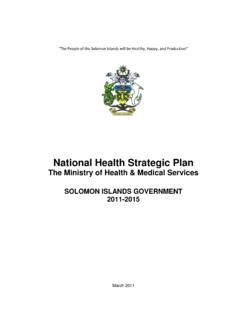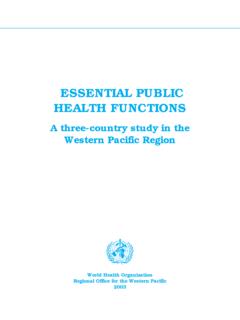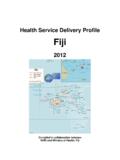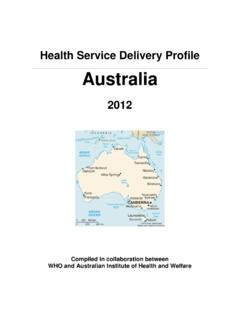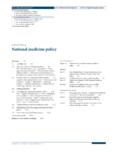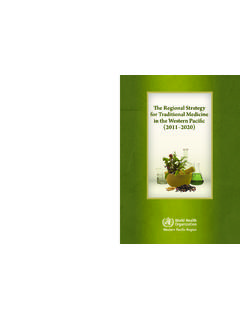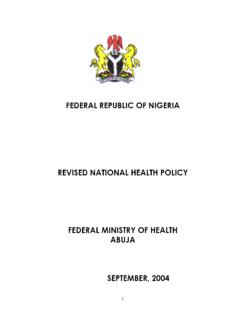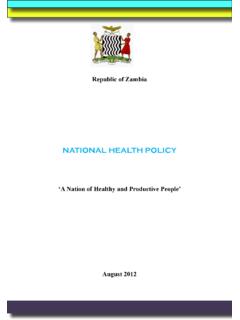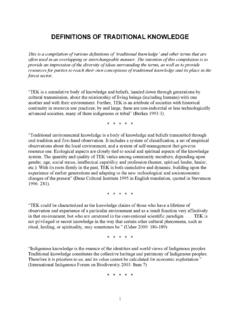Transcription of WHO Trad itional Medicine Strategy 2002–2005
1 WHOTr a ditionalMedicineStrategy2002 2005 WorldHealthOrganizationGeneva World Health Organization 2002 This document is not a formal publication of the World Health Organization (WHO), and all rights are reserved by theOrganization. The document may, however, be freely reviewed, abstracted, quoted, reproduced or translated, in partor in whole, but not for sale nor for use in conjunction with commercial views expressed in documents by named authors are solely the responsibility of those designations employed and the presentation of material on maps included in this document do not imply theexpression of any opinion whatsoever on the part of the World Health Organization concerning the legal status ofany country, territory, city or area of its authorities.
2 Or concerning the delimitation of its frontiers or lines represent approximate border lines for which there may not yet be full & layout by Renata Kerr DesignWHOTr a ditionalMedicineStrategy2002 2005 WorldHealthOrganizationGenevaWHO/EDM/ : EnglishDistribution: GeneralWHO traditional Medicine Strategy 2002 2005iiThis is the first global WHO traditional Medicine Strategy . It was drafted followingextensive consultation. However, given regional diversity in the use and role oftraditional Medicine , and complementary and alternative Medicine , modificationsmay be necessary to take account of variations at regional levels. Additionally, itshould be noted that difficulties persist in defining precise terminology fordescribing their therapies and products.
3 The validity of related data is also fre-quently problematic. Methodologies used to collect data are often not comparableand parameters not clearly determined. The traditional Medicine team at WHOH eadquarters would therefore welcome comments on any of the data included inthis Strategy . They should be sent to: Dr Xiaorui Zhang, Acting Team Coordinator, traditional Medicine , Department of Essential Drugs and Medicines Policy, WorldHealth Organization, Avenue Appia 20, 1211 Geneva 27, Switzerland or emailed vAcronyms, abbreviations & WHO viiKey points: WHO traditional Medicine Strategy 2002 2005 .. 1 What is traditional Medicine ?.. 1 Widespread and growing use.
4 1 Why such broad use?.. 2 Uncritical enthusiasm versus uninformed 2 Challenges in developing TM/CAM current role of WHO .. 4 Framework for 5 Strategy 61. Global review .. What is traditional Medicine ? Towards a working Broad use and Accounting for use and increasing Responding to the popularity of 152. What needs to be done? .. National policies and legal framework .. Safety, efficacy, Rational use .. 26 ContentsWHO traditional Medicine Strategy 2002 2005iv3. The current role of Developing TM/CAM and integrating it into national health care systems .. Ensuring appropriate, safe and effective use of traditional Medicine .
5 Increasing access to TM/CAM information ..324. International and national resources for traditional Medicine .. UN International Nongovernmental Global professional International and national professional Specific 415. Strategy and Plan of Action 2002 : Integrate TM/CAM with national health care systems, as appropriate,by developing and implementing national TM/CAM policies and programmes .. , efficacy and quality: Promote the safety, efficacy and qualityof TM/CAM by expanding the knowledge-base on TM/CAM, and byproviding guidance on regulatory and quality assurance standards .. : Increase the availability and affordability of TM/CAM, with anemphasis on access for poor use: Promote therapeutically sound use of appropriate TM/CAMby providers and 48 Annex 1: List of WHO Collaborating Centres for traditional 49 Annex 2: Selected WHO publications and documents on traditional Medicine .
6 51 National policy and 51 Quality, safety and 51 Rational 52 WHO Collaborating Centres for traditional 55 Index .. 59vTAcknowledgements his Strategy was developed by WHOH eadquarters and Regional Office staffworking in essential drugs and medicinespolicy, in consultation with other WHOprogramme staff and with key developmentpartners. It was then finalized in consultationwith representatives from Member States,the wider UN family, nongovernmental andother international organizations, WHOC ollaborating Centres for TraditionalMedicine and WHO Expert covers country, regional, interregional andglobal work, and builds on discussions heldduring the WHO Consultation on Method-ologies for Research and Evaluation ofTraditional Medicine (11 14 April 2000)attended by experts in traditional Medicine ,as well as by WHO Headquarters andRegional Office staff working in traditionalmedicine.
7 The meeting was followed by aseries of conference calls between WHOH eadquarters and Regional Offices, as wellas conference calls with Member States andUN partners, to review drafts of the WHOT raditional Medicines Strategy 2002 gratefully acknowledges the activeparticipation and constructive commentsreceived from members of the globalextended medicines family including:Member States: Armenia (E. Gabrielyan),Australia (G. Morrison), Belgium (J. Laruelle),Canada (Y. Bergevin, P. Chan), China (M. Chan,T. Leung, L. Peilong), Denmark (P. Rockhold),Germany (K. Keller), Ghana (E. Mensah),India (S. Chandra), Indonesia (K. Ritiasa),Italy (P. Procacci), Iran (M. Cheraghali), Japan(A.)
8 Yokomaku), Netherlands (M. ten Ham),Nigeria (T. Fakeye), Norway (O. Christiansen,E. Salvesen), Pakistan (F. Chowdhary),Republic of Korea ( Han), Sweden(A. Nordstr m), Thailand ( Songkhla),United Kingdom (J. Lambert), United States(B. Clay, L. Vogel), Viet Nam (L. Van Truyen),Zimbabwe (L. Matondo).Other UN and multilateral agencies:European Commission (L. Fransen), UNAIDS(J. Perriens), UNDP (M. Bali), UNESCO(M-F. Roudil), WIPO (S. Bhatti), World Bank(R. Govindaraj).Nongovernmental organizations andfoundations: Ford Foundation (V. DavisFloyd), Islamic Organization for MedicinalSciences (A. Awady), John D. and CatherineT. MacArthur Foundation (D. Martin), Rocke-feller Foundation (A.
9 So), WSMI (H. Cranz,J. Reinstein), Li Ka Shing Foundation (K. Lo).WHO Collaborating Centres for Tradi-tional Medicine : National Center forComplementary and Alternative Medicine ,Bethesda (N. Hazleton), University of Illinoisat Chicago, Chicago (N. Farnsworth).WHO Expert Committees and Panels:F. Takaku, D. Regional Offices: AFRO (O. Kasilo,E. Samba), AMRO/PAHO (G. Alleyne, C. Borras,R. D Alessio, S. Land, D. L pez-Acu a, Silva), EMRO (H. Gezairy, P. Graaff,A. Salih), EURO (M. Danzon, K. de Joncheere),SEARO (P. Abeykoon, Rafei, K. Shein),WPRO (K. Chen, S. Omi).AcknowledgementsWHO traditional Medicine Strategy 2002 2005viWHO Headquarters (Department ofEssential Drugs and Medicines Policy):G.
10 Baghdadi, A. Creese, J. Graham,H. Hogerzeil, Y. Maruyama, J. Quick, L. Rag ,J. Sawyer, G. Vel squez, D. Whitney, X. Headquarters (other programmes) Adams (EIP/OSD), Alwan(NMH/MNC), A. Asamoa-Baah (EGB),R. Bengoa (NMH/CCH), J. Cai (WKC), J. Frenk(EIP), D. Heymann (CDS), Y. Kawaguchi(WKC), B. Kean (EGB/ECP), A. Kern (GMG),M. T. Mbizvo (FCH/RHR), A. Mboi (FCH/WMH), D. Nabarro (DGO), B. Saraceno(NMH/MSD), Y. Suzuki (HTP), D. Tarantola(Senior Policy Adviser), T. T rmen (FCH),E. M. Wallstam (SDE/HSD), D. Yach (NMH).T. Falkenberg, J. Sawyer and X. Zhangdrafted the Strategy and J. Graham, Quick, J. Sawyer, P. Thorpe, D. Whitneyand X. Zhang undertook revision andediting.

